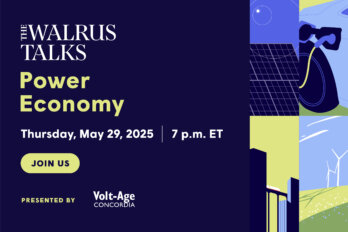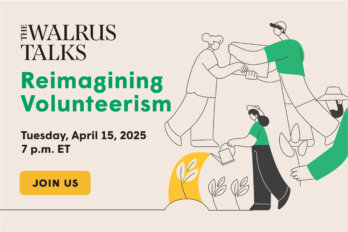Roberta Jamieson, First Nations activist and the first Indigenous woman ever to earn a law degree in Canada, spoke at The Walrus Talks IMPACT, on February 25, 2020, in Toronto.
You can watch all The Walrus Talks speakers from this event here: The Walrus Talks Impact on YouTube
Good evening. I am proud to be a partner with Walrus. My name’s Roberta Jamieson and I salute Walrus for giving Indigenous people voice, both at your events and in your publications. We’re meeting tonight at a very challenging time in Indigenous/non-Indigenous relations in the country. You may have noticed Indigenous people have moved from truth to reconciliation in a way that is demanding structural and systemic change. No longer looking for a seat at the existing tables, but looking for new tables. If ever there was a time for partnership, it is now. Indspire’s role in the country is to use education to build capacity, to educate. Our tagline is Indigenous Education, Canada’s Future.
We’re educating Canadians about Indigenous people, contributions that have been made through the Indspire awards and other events so that we can understand our shared history. At the same time, we’re educating Indigenous students, this fastest growing demographic in the country, hence Indigenous Education Canada’s Future. I’m proud to say that we’ve raised over the last number of years, certainly since I’ve been with Indspire, from all of you, raised and distributed more than $115 million through 37,500 bursaries and 90% of the students we support, graduate. So these are young Indigenous people looking for an opportunity, a way to achieve their potential, looking to create sustainable Indigenous communities and a prosperous and inclusive Canada.
Well, I think there are new partnerships ahead where Indigenous people can implement their own solutions. No question, there are gaps that remain to be filled. You probably know the statistics, I’ll give you only one. Four out of 10 First Nations young people on reserve will graduate from high school. Nine out of 10 non-Indigenous children will graduate from high school. This is Canada. This is 2020. If we were to close that gap, it would add more than $30 billion to Canada’s GDP by 2031. It seems obvious to me that that is a solid business case. I stand here hopeful and optimistic that change is happening. I’ll give you some examples.
We’ve worked with The Slaight Family Foundation, a name you know well in this town, The Slaight Family consultant and quite a number of leaders and experts to figure out how they could best support addressing Indigenous issues in the country. They focus their giving, $12 million to 15 organizations of which we’re one, they focused it on programs designed to produce longterm benefits for Indigenous youth in their communities. They developed criteria for their giving. One, help Indigenous communities build their own capacity. Two, leave a longterm legacy. Three, pick organizations that are led by or directed by Indigenous people. Partnerships, and partnerships are hard work, it will take a great deal of hard work for Indigenous communities to heal and build our own communities, but also for all of us to work together to shape the future.
Partnerships. Indspire looks for valuable partnerships everywhere we go, but we also walk away from partnerships because they’re not meeting our end goals.
Our North Star is within a generation every Indigenous student will graduate.
If you’re not interested in that, well find another partner. We’ve also walked away from partners who want us to deliver the Indigenous community on a platter, but don’t want to do their homework. Working with our people requires work, so we developed our own criteria for partnerships because we want to create measurable impact, like 90% students graduate. It includes, this is not exhaustive, I’m happy to share it all with you if you like. When you look at whether the relationship with the partner has clear, tangible, measurable benefits. we look at whether the partnership would help us achieve our strategic plan. We look at our vision and the vision of the potential partner is aligned. Well, that approach is paying off.
Two examples. One with $1 million from the Pathé Foundation and also funding from the Kenny Family Foundation. We’ve launched a project in Winnipeg called Teach for Tomorrow. Again, partnering with the Winnipeg School Board and the University of Winnipeg, identifying Indigenous students in high school who want to be educators, supporting them to graduation, supporting them with bursaries, supporting them with a job and transition to support their own people. Number two example, the Canadian geographic society. We worked with the Royal Canadian Geographic Society and other stakeholders to come up with an Indigenous atlas. It includes hard-copy and a ginormous floormat and that is being shared in many schools and with school boards across the country. And we asked them to ignore some of the boundaries that came later, and to look at the names and the origins from the Indigenous lens. You name any town practically in the country, you name Ontario, Ottawa, Toronto. I mean I could go on, Saskatchewan. They have an Indigenous route and what better way to show that.
These are only two examples of organizations that are changing the way they’re doing philanthropy, decolonizing in many ways, and understanding how to embrace a future in working with Indigenous people, starting a journey that begins with a very simple ingredient, humility. Many other partnerships we’re keen on, working with universities, working with colleges, working with corporations, other foundations who want to invest in the education of Indigenous people and the future of Canada. And we have a very attractive matching program, which I’m happy to tell you about it at the reception. These are partners who understand the importance of investing, who understand the value of mentorship by and for and with young Indigenous people, and they understand the benefits to Canada. A Canada that we are committed to shaping together through partnership.
Thank you for listening to my words.





